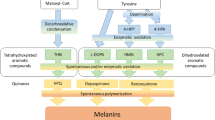Abstract
The autoinduction and glucose repression of luciferase synthesis in batch cultures and continuous cultures of Vibrio fischeri were investigate. As previously reported, a lag in luciferase synthesis occurred in glycerol-grown batch cultures and addition of d-glucose to the medium extended the lag period. A phosphate-limited chemostat culture with d-glucose as energy source (specific growth rate, μ=0.45 h-1) contained uninduced levels of luciferase. Luciferase activity increased to an induced level upon addition of c-AMP or autoinducer to such a chemostat culture while cell mass remained constant. Furthermore, when μ of a phosphate-limited chemostat culture containing d-glucose as energy source was decreased from 0.45 to 0.30 h-1, luciferase activity increased from an uniduced to induced level. After exogenously added c-AMP or autoinducer was diluted out of a phosphate-limited continous culture or after μ was increased to 0.45 h-1, luciferase activity remained at an induced level. Apparently, luciferase in V. fischeri was subject to a catabolite repression by d-glucose that could be overridden by autoinduction or by an autogenous control element.
Similar content being viewed by others
References
Baross JA, Tester PA, Morita R (1978) Incidence, microscopy, and etiology of exoskeleton lesions in the tanner crab, Chinocetes tanneri J Fish Res Board Can 35:1141–1149
Baumann P, Baumann L, Bang SS, Woolkalis MJ (1980) Reevaluation of the taxonomy of Vibrio, Beneckea, and Photobacterium: abolition of the genus Beneckea. Curr Microbiol 4:127–133
Brammar WJ, Clarke PH (1964) Induction and repression of Pseudomonas aeruginosa amidase. J Gen Microbiol 37:307–319
Clarke PH, Brammar WJ (1964) Regulation of bacterial enzyme synthesis by induction and repression. Nature 203:1153–1155
Clarke PH, Houldsworth MA, Lilly MD (1968) Catabolite repression and the induction of amidase synthesis by Pseudomonas aeruginosa 8602 in continuous culture. J Gen Microbiol 51:225–234
Eberhard A (1972) Inhibition and activation of bacterial luciferase synthesis. J Bacteriol 109:1101–1105
Eberhard A, Eberhard C, Burlingame AL, Kenyon GL, Oppenheimer NJ, Nealson KH (1981) Purification, identification and synthesis of Photobacterium fischeri autoinducer. In: Deluca M, McElroy W (eds) A symposium on bioluminescence and chemiluminescence; basic chemistry and analytical applications. Academic Press, New York, pp 113–120
Greenberg EP, Hastings JW, Ulitzur S (1979) Induction of luciferase synthesis in Beneckea harveyi by other marine bacteria. Arch Microbiol 120:87–91
Harvey EN (1952) Bioluminescence. Academic Press Inc. New York
Hastings JW, Mitchell G (1971) Endosymbiotic bioluminescent bacteria from the light organ of pony fish. Biol Bull 141:261–268
Hastings JW, Nealson KH (1977) Bacterial bioluminescence. Annu Rev Microbiol 31:549–595
Hastings JW, Nealson KH (1981) The symbiotic luminous bacteria. In: Starr MP, Stolp H, Truper HG, Ballows A, Schlegel HG (eds) The prokaryotes, a handbook on habitats, isolation and identification of bacteria. Springer, New York, pp 1332–1345
Hastings JW, Weber G (1963) Total quantum flux of isotopic sources. J Optical Soc Amer 53:1410–1415
Herbert D, Phipps PJ, Strange RE (1971) Chemical analysis of microbial cells. In: Norris JR, Ribbons DW (eds) Methods in microbiology, vol 5B, pp 209–344
Herring PJ, Morin JG (1978) Bioluminescence in fishes pp 273–329. In: Herring PJ (ed) Bioluminescence in action. Academic Press Inc, New York
Jannasch HW (1967) Growth of marine bacteria at limiting concentrations of organic carbon in seawater. Limnol Oceanogr 12:264–271
Nealson KH (1977) Autoinduction of bacterial luciferase: Occurrence, mechanism and significance. Arch Microbiol 112:73–79
Nealson KH (1978) Isolation, identification and manipulation of luminous bacterial. In: Colowick SP, Kaplan NO (eds) Methods in enzymology, vol 57, pp 153–165, Academic Press, New York
Nealson KH, Eberhard A, Hastings JW (1972) Catabolite repression of bacterial bioluminescence: functional implications. Proc Nat Acad Sci USA 69:1073–1076
Nealson KH, Platt T, Hastings JW (1970) Cellular control of the synthesis and activity of the bacterial luminescent system. J Bacteriol 104:313–322
Rosson RA, Nealson KH (1981) Autoinduction of bacterial bioluminescence in a carbon limited chemostat. Arch Microbiol 129:299–304
Ruby EG, Greenberg EP, Hastings JW (1980) Planktonic marine luminous bacteria: Species distribution in the water column. Appl Environ Microbiol 39:302–306
Ruby EG, Morin JG (1979) Luminous enteric bacteria of marine fishes: a study of their distribution, densities and dispersion. Appl Environ Microbiol 37:1230–1238
Ruby EG, Nealson KH (1976) Symbiotic association of Photobacterium fischeri with the marine luminous fish Monocentris japonica: A model of symbiosis based on bacterial studies. Biol Bull 151:574–586
Ruby EG, Nealson KH (1978) Seasonal changes in the species composition of luminous bacteria in nearshore seawater. Limnol Oceanogr 23:530–533
Tyler B, Magasanik B (1970) Physiological basis of transient repression of catabolite enzymes in Escherichia coli. J Bacteriol 120:411–422
Ullmann A, Monod J (1968) Cyclic AMP as an antagonist of catabolite repression in Escherichia coli. FEBS Lett 2:57–60
Yetinson T, Shilo M (1979) Seasonal and geographical distribution of luminous bacteria in the eastern Mediterranean Sea and the Gulf of Elat. Appl Environ Microbiol 37:1230–1238
Author information
Authors and Affiliations
Rights and permissions
About this article
Cite this article
Friedrich, W.F., Greenberg, E.P. Glucose repression of luminescence and luciferase in vibrio fischeri . Arch. Microbiol. 134, 87–91 (1983). https://doi.org/10.1007/BF00407937
Received:
Accepted:
Issue Date:
DOI: https://doi.org/10.1007/BF00407937




